
8,000
RTX-200
Savanna Army Depot
7,000
6,000
5,000
4,000
3,000
2,000
1,000
0
0
5
10
15
20
25
Time (min)
l) GC-ECD confirmation column (RTX-200), Savanna Army Depot.
Figure 2 (cont'd). Chromatograms from field-contaminated soils (25 g extracted with 50 mL acetonitrile).
soils (Fig. 2). We preconcentrated a few samples
tration analyte, and the TNT, in this case, was prob-
using solid-phase extraction to see if the analytes
ably present as in impurity in 2,4-DNT, not as a
of interest would preferentially be retained on the
high-explosive residue. We found 2,4-DNT in 11
solid-phase disk. This very time-consuming
of the 13 extracts, over the concentration range 0.94
to 8587 g/kg (Table A2). Two of the soils showed
sample preparation step did not provide any
benefits in terms of cleanup or detectability.
extreme heterogeneity for this analyte with con-
centration estimates of 36 and 8587 g/kg in du-
Rather, all peak heights, analytes and inter-
plicates for one sample, and 145 and 4096 g/kg
ferences, increased in proportion to the pre-
concentration.
in duplicates for another sample. At the sites where
The only DNB isomer detected was 1,3-DNB,
these soils (Eagle River Flats OB/OD Pad and
which we found in two of the soils at around 5
Camp Shelby NE Quad) were collected, propel-
g/kg (Table A2).
lant grains were scattered across the soil surfaces.
Recoveries from the MS/MSD samples were ex-
2,4-DNT is a propellant ingredient, and such ex-
cellent in some samples and low in others (Table
treme heterogeneity is consistent with particulate
A2). Matrix effects are discussed later.
contamination, such as from a propellant grain
TNT and 2,4-DNT concentrations above 20 g/
fragment. In the samples with relatively high 2,4-
kg were quantifiable by HPLC, and we correlated
DNT concentrations, 2,6-DNT and 3,4-DNT were
the GC concentrations estimates (including the
also detected by GC. These two isomers co-eluted
MS/MSD without subtracting the spiked amount)
on the HPLC separation. Thus, 3,4-DNT is not
with those newly obtained by HPLC using splits
suitable as an internal standard for extracts from
of the same extract. Each data point (Fig. 3) repre-
soils contaminated with high concentrations of 2,4-
sents a single sample (not a mean of duplicates).
DNT.
Again we found good correlation (r = 0.997 for
The Am-DNT isomers were detected in 10 of
both analytes) between the two methods of deter-
the 13 soils by GC (Table A2). For the samples from
mination, and again we found that the slopes
Fort Ord, several unidentified peaks eluted near
of the least-squares models were greater than 1.00
the Am-DNTs on the GC analysis and made quan-
(1.14 and 1.12 for TNT and 2,4-DNT, respect-
tification difficult. Similar interferences were not
ively), indicating slightly higher estimates by GC
observed in other soils, although an unidentified
peak did elute after 2-Am-DNT from four other
(Fig. 3).
12



 Previous Page
Previous Page
